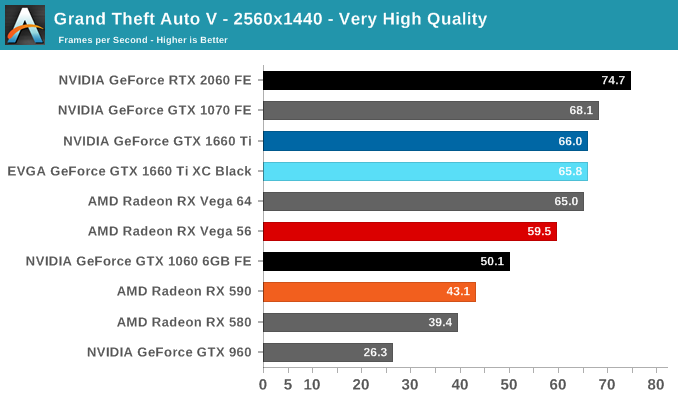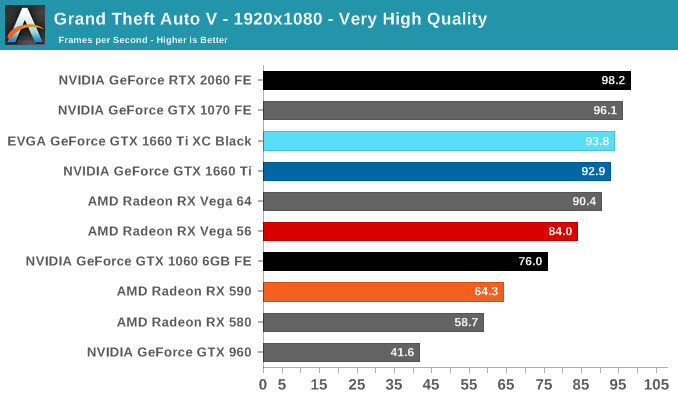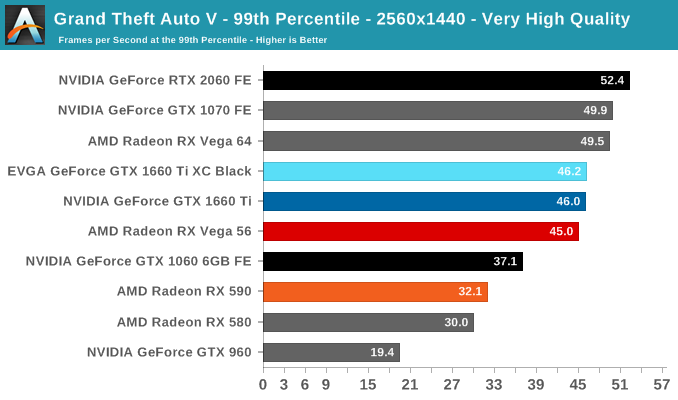The NVIDIA GeForce GTX 1660 Ti Review, Feat. EVGA XC GAMING: Turing Sheds RTX for the Mainstream Market
by Ryan Smith & Nate Oh on February 22, 2019 9:00 AM ESTGrand Theft Auto V (DX11)
Now a truly venerable title, GTA V is a veteran of past game suites that is still graphically demanding as they come. As an older DX11 title, it provides a glimpse into the graphically intensive games of yesteryear that don't incorporate the latest features. Originally released for consoles in 2013, the PC port came with a slew of graphical enhancements and options. Just as importantly, GTA V includes a rather intensive and informative built-in benchmark, somewhat uncommon in open-world games.
The settings are identical to its previous appearances, which are custom as GTA V does not have presets. To recap, a "Very High" quality is used, where all primary graphics settings turned up to their highest setting, except grass, which is at its own very high setting. Meanwhile 4x MSAA is enabled for direct views and reflections. This setting also involves turning on some of the advanced rendering features - the game's long shadows, high resolution shadows, and high definition flight streaming - but not increasing the view distance any further.
We've updated some of the benchmark automation and data processing steps, so results may vary at the 1080p mark compared to previous data.




For the GTX 1660 Ti, it's becoming clear that it is beyond firmly faster than the RX 590, its nominal competition at the $279 price point. The card pips the RX Vega 64, putting it in the realm of 1.4X to 1.5X faster than the RX 590, and around 10% faster than the RX Vega 56.
There's no mincing words here; while NVIDIA hardware may run better on GTA V in general, the size of GTX 1660 Ti's lead over the RX 590 is just crushing for the same MSRP, and equally so against the generally pricier RX Vega 56.











157 Comments
View All Comments
Psycho_McCrazy - Tuesday, February 26, 2019 - link
Given that 21:9 monitors are also making great inroads into the gamer's purchase lists, can benchmark resolutions also include 2560.1080p, 3440.1440p and (my wishlist) 3840.1600p benchies??eddman - Tuesday, February 26, 2019 - link
2560x1080, 3440x1440 and 3840x1600That's how you right it, and the "p" should not be used when stating the full resolution, since it's only supposed to be used for denoting video format resolution.
P.S. using 1080p, etc. for display resolutions isn't technically correct either, but it's too late for that.
Ginpo236 - Tuesday, February 26, 2019 - link
a 3-slot ITX-sized graphics card. What ITX case can support this? 0.bajs11 - Tuesday, February 26, 2019 - link
Why can't they just make a GTX 2080Ti with the same performance as RTX 2080Ti but without useless RT and dlss and charge something like 899 usd (still 100 bucks more than gtx 1080ti)?i bet it will sell like hotcakes or at least better than their overpriced RTX2080ti
peevee - Tuesday, February 26, 2019 - link
Do I understand correctly that this thing does not have PCIe4?CiccioB - Thursday, February 28, 2019 - link
No, they have not a PCIe4 bus.Do you think they should have?
Questor - Wednesday, February 27, 2019 - link
Why do I feel like this was a panic plan in an attempt to bandage the bleed from RTX failure? No support at launch and months later still abysmal support on a non-game changing and insanely expensive technology.I am not falling for it.
CiccioB - Thursday, February 28, 2019 - link
Yes, a "panic plan" that required about 3 years to create the chips.3 years ago they already know that they would have panicked at the RTX cards launch and so they made the RT-less chip as well. They didn't know that the RT could not be supported in performance with the low number of CUDA core low level cards have.
They didn't know that the concurrent would have played with the only weapon it was left to it to battle, that is prize as they could not think that the concurrent was not ready with a beefed up architecture capable of the sa functionalities.
So, yes, they panicked for sure. They were not prepared to anything of what is happening,
Korguz - Friday, March 1, 2019 - link
" that required about 3 years to create the chips.3 years ago they already know that they would have panicked at the RTX cards launch and so they made the RT-less chip as well. They didn't know that the RT could not be supported in performance with the low number of CUDA core low level cards have. "
and where did you read this ? you do understand, and realize... is IS possible to either disable, or remove parts of an IC with out having to spend " about 3 years " to create the product, right ? intel does it with their IGP in their cpus, amd did it back in the Phenom days with chips like the Phenom X4 and X3....
CiccioB - Tuesday, March 5, 2019 - link
So they created a TU116, a completely new die without RT and Tensor Core, to reduce the size of the die and lose about 15% of performance with respect to the 2060 all in 3 months because they panicked?You probably have no idea of what are the efforts to create a 280mm^2 new die.
Well, by this and your previous posts you don't have idea of what you are talking about at all.